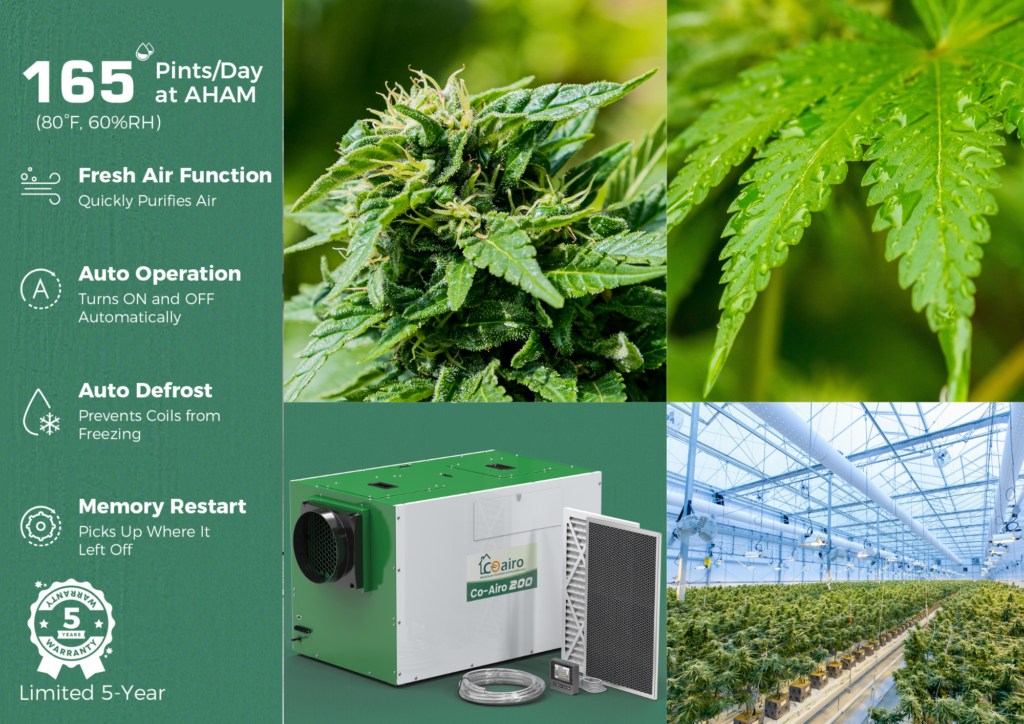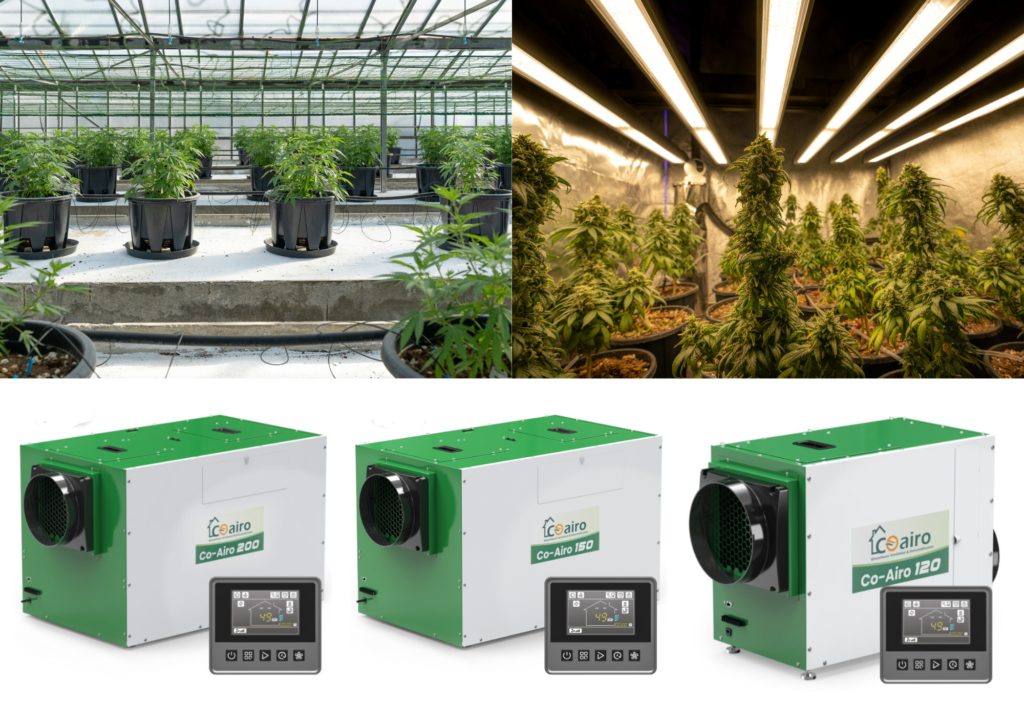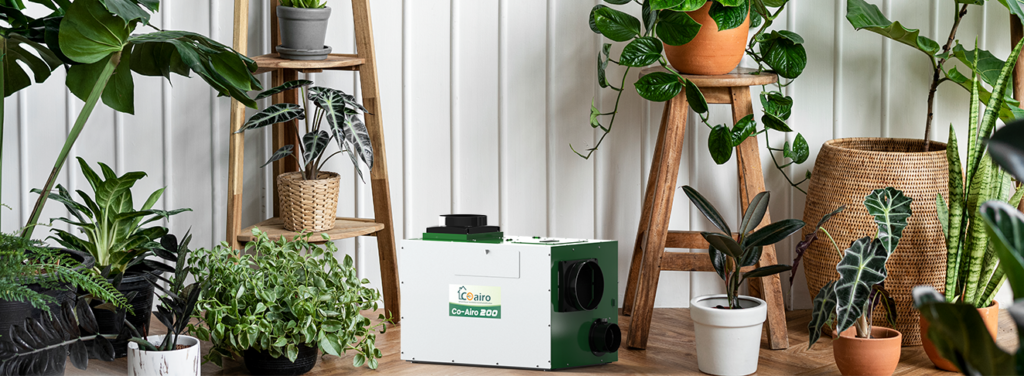Global demand for cannabis is on the rise due to its medical and recreational use. This creates the challenge of growing cannabis indoors efficiently and sustainably to meet the growing demand. Therefore, optimizing climate control in indoor cannabis greenhouses is essential to enhance the yield and quality of the final product. Proper management of temperature for growing cannabis, humidity level for cannabis, and airflow ensures healthier plants and maximizes production.
Key Factors in Indoor Cannabis Climate Control
The cannabis growth cycles, flowering, yield, and the concentration of active compounds (such as THC and CBD) are directly affected by the following factors:
- Temperature for growing cannabis
- Humidity for cannabis seedlings
- CO2 concentration level
- Airflow & Ventilation
- Light
Correct cannabis climate control techniques help to prevent unfavourable conditions, such as plant diseases, and to avoid problems like humidity and temperature fluctuations, while ensuring healthy growth and better yield.
Temperature Control for Growing Cannabis
|
Optimal Temperature |
Vegetative Stage |
Flowering Stage |
|
20°C ~30°C |
22°C ~ 26°C |
18°C ~24°C |
According to researchers, the optimal temperature for indoor cannabis growth lies between 20°C ~30°C, although it can fluctuate an additional 5°C to 10°C depending on whether it is daytime or nighttime. Temperatures higher or lower than these values may slow down the photosynthesis process and cause stress to the plants. These unfavorable conditions ultimately lead to slower growth of the cannabis plant.
While the ideal temperature for the vegetative stage is between 22°C ~ 26°C, the flowering stage only requires slightly lower temperatures in the range 18°C ~ 24°C to promote flower bud formation.

Humidity Control for Cannabis
Humidity control also plays a crucial role in indoor weed cultivation. This is the most significant climate factor of all, as humidity, unlike other factors, is difficult to notice without specialized equipment. Excessive humidity levels can cause mold, fungi, and other diseases. On the other hand, insufficient humidity levels can lead to water loss in cannabis plants. Water loss in cannabis plants affects their root development and overall health.
Researchers suggest the following optimal humidity levels for cannabis growing:
|
Vegetative Stage |
Flowering Stage |
|
50% ~ 70% (RH) |
40% ~ 50% (RH) |
|
0.8 ~ 1.2 kPa |
1.0 ~ 1.6 kPa |
The ideal humidity level for growing cannabis is chosen to be between 40% to 70% (RH) by most cannabis farmers. In terms of vapor pressure deficit (VPD), the ideal humidity lies in the 0.8 kPa to 1.6 kPa range. In the seedling and early vegetative stages, the humidity level should be between 70% to 80% (0.4kPa – 0.8kPa), while the late vegetative stage demands a value between 55% to 70% (0.8kPa – 1.2kPa). Early and late flowering stages require an ideal humidity level between 50% to 60% (0.8kPa – 1.2kPa) and 40% to 50% (1.0kPa – 1.4kPa), respectively.
Maintaining humidity at the above levels contributes massively to the sustained growth of cannabis plants and to their overall health. Ideal humidity levels in cannabis plants prevent mold build-up. Researchers identify two types of molds that pose the highest risk to cannabis plants. They are powdery mildew and gray mold (also known as bud rot or botrytis). These molds can quickly spread to the whole greenhouse if care is not taken to ensure proper humidity levels for growing cannabis. Growers may need to discard the entire plant nursery if these mildews infect their crops. Therefore, preventive methods should be taken to ensure the cannabis plants are not infected with these fungal diseases. Furthermore, there are strict regulations in place for medicinal and recreational cannabis products that require growers to ensure the crops are not infected with mold.

Fortunately, the mold build-up in cannabis plants can be controlled by regulating the above ideal humidity levels. Fungal diseases like powdery mildew and gray mold require high humidity or even dew point condensation to grow. Efficient and reliable humidity control equipment should be used to maintain the humidity at desired levels. Cannabis growers resort to either dehumidifiers or HVAC (Heating, Ventilation, and Air Conditioning) systems to control humidity. Dehumidifiers like Co-Airo 200 use state-of-the-art heat exchangers to remove excess moisture from the air efficiently. Although HVAC systems regulate the humidity level as a side effect, their primary purpose is to control the temperature. Therefore, this method is proven to be inefficient at maintaining ideal humidity levels for growing cannabis indoors, and growers are gradually deviating from using HVAC systems to regulate humidity.
Best CO2 Concentration for Indoor Cannabis
Indoor cannabis plants require a sufficient concentration of CO2 for photosynthesis. An adequate supply of CO2 ensures that the plants are in good health and the yield is maximised.
Many research articles set the ideal level of CO2 concentration for indoor cannabis cultivation to be between 1000ppm and 1500ppm. When the CO2 levels are increased, the temperature and humidity levels should also be optimised simultaneously to guarantee optimal climate conditions.
CO2 generators, bottled CO2, or CO2 injection systems can be used to guarantee proper CO2 concentration.
Light Requirements for Growing Cannabis
Cannabis is a long-day plant. This means the quality, intensity, and duration of light are important for its growth. The light needs of the cannabis plants can vary according to their growth stages. Different light cycles directly affect the yield and quality.
|
|
Vegetative Stage |
Flowering Stage |
|
Time Duration |
18 hours per day |
12 hours per day |
|
Light Intensity |
300-600 µmol/m²/s |
600-1000 µmol/m²/s |
Adequate lighting equipment should be selected, and its light cycles should be adjusted to match the cannabis plant’s growth phase. Automated light control systems should be used to minimize human error.

Airflow and Ventilation for Indoor Cannabis
Even if all the climate factors are set to ideal levels, they will not remain stable if proper airflow and ventilation systems are not available. Regulated airflow prevents unnecessary buildup of heat, moisture, and harmful gases. It also promotes healthy plant respiration and growth.
Common diseases that cannabis plants are vulnerable to, including powdery mildew and downy mildew, can be prevented if the airflow is optimised.
Ventilation systems can be set up using fans, exhaust systems, and air exchangers. They ensure even airflow and prevent stagnant air, which can lead to mold and pest problems.
Summary for Cannabis Climate Control
Climate conditions and environmental control are major factors when it comes to indoor cannabis growing. The climate factors affecting the growth of cannabis plants include temperature, humidity, CO2 concentration, airflow, and light. These factors also interact with one another. When optimum levels are maintained, these factors support healthy plant growth, enhance photosynthesis, prevent the growth of mold and disease, and increase the concentration of active compounds (such as THC and CBD). Therefore, proper climate control is beneficial and essential for consistently high-quality results.


